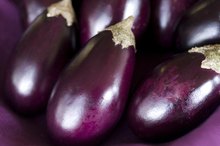Allergic Reaction to Spicy Foods
While plenty of Thai curry aficionados delight over blazing hot peppers, others find that spicy foods cause unpleasant reactions such as profuse sweating. A reaction such as sweating is a food sensitivity, not an actual food allergy. By contrast, examples of allergic reactions include hives, itchy mouths, wheezing or the closing of the throat. A runny nose, sweating, diarrhea, gas or headaches are more typically food sensitivities. While it's most common to have sensitivity to spicy foods, it's also possible to have an allergy.
If you are experiencing serious medical symptoms, seek emergency treatment immediately.
Allergies to Pepper
Various peppers, from cayenne to paprika, can cause allergic reactions. Often, the allergy is not to the edible fruit of the plant, which is used in cooking, but actually to the plant's pollen. Bell peppers, typically a sweeter variety of the capsicum family, can also trigger allergic reactions due to the presence of profilin, a type of protein. The presence of profilin varies according to the particular type of bell pepper, making it possible for allergy sufferers to consume certain peppers without problems.
- Various peppers, from cayenne to paprika, can cause allergic reactions.
- Bell peppers, typically a sweeter variety of the capsicum family, can also trigger allergic reactions due to the presence of profilin, a type of protein.
Sister Allergens
Home Remedy for a Jalapeño Pepper Allergy
Learn More
If you experience an allergic reaction upon eating cayenne pepper, it's likely that you will also have an allergy to chestnuts and to fleshy fruits such as bananas, kiwi or avocados. Latex also triggers allergic reactions in many individuals with pepper allergies.
Allergies to Spicy Sauces and Condiments
In many cases, the ingredients in a spicy dish that bring the heat do not necessarily cause the allergy. Many sauces and condiments that include a piquant herb or spice also contain more common allergens. Chinese XO sauce contains a mixture of seafood as well as spicy chilies. Korean Gochuchang paste contains glutinous rice powder as well as red peppers. Many Thai sauces contain peanuts or powdered, dried shellfish in addition to chilies. In addition, many Asian cuisines prepare spicy dishes in oils derived from peanuts or other seeds or nuts, which can be common allergens.
- In many cases, the ingredients in a spicy dish that bring the heat do not necessarily cause the allergy.
- In addition, many Asian cuisines prepare spicy dishes in oils derived from peanuts or other seeds or nuts, which can be common allergens.
Possible Reactions
Allergy to Eggplant
Learn More
Allergic reactions vary from minor disturbances to life-threatening conditions. If you have a history of extreme reactions to any of the sister allergies commonly linked with peppers and spicy foods, it's best to avoid eating any of the potential allergens, even in small quantity 3. Cayenne pepper, for example, can cause:
- anaphylaxis
- a sudden
- potentially deadly condition that can involve hives
- swelling around the throat
- nasal passages
- an irregular or rapid heartbeat
- diarrhea
- dizziness or nausea
The body goes into anaphylaxis when the immune system overreacts tp an allergen in an attempt at protection from the allergen. This causes a sudden drop in blood pressure and life-threatening symptoms. If you simply experience some sweating or a runny nose upon eating spicy foods, it's more likely that you have a food sensitivity or gustatory rhinitis, instead of an actual allergy.
- Allergic reactions vary from minor disturbances to life-threatening conditions.
- If you simply experience some sweating or a runny nose upon eating spicy foods, it's more likely that you have a food sensitivity or gustatory rhinitis, instead of an actual allergy.
Related Articles
References
- Clemson Cooperative Extension: Food Allergies
- "Allergy"; Characterization of Allergens in Plant-derived Spices; C. Ebner et al; 1998
- "International Archives of Allergy and Immunology"; Bell Peppers Express Allergens Depending on the Horticultural Strain; E. Jenson-Jarolim, et al; June 1998
- The Food Domain of Michigan State University: Ethnic Foods and Food Allergies
- Peppers, sweet, red, raw. FoodData Central. U.S. Department of Agriculture. Published April 1, 2019.
- Pepper, sweet, green, raw. U.S. Department of Agriculture. Published April 1, 2020.
- National Institutes of Health Office of Dietary Supplements. Vitamin C fact sheet for health professionals. Updated July 9, 2019.
- National Institutes of Health Office of Dietary Supplements. Manganese fact sheet for health professionals. Updated September 6, 2019.
- Fiedor J, Burda K. Potential role of carotenoids as antioxidants in human health and disease. Nutrients. 2014;6(2):466-88. doi:10.3390/nu6020466
- Mozos I, Stoian D, Caraba A, Malainer C, Horbańczuk JO, Atanasov AG. Lycopene and Vascular Health. Front Pharmacol. 2018;9:521. doi:10.3389/fphar.2018.00521
- Shotorbani N, Jamei R, Heidari R. Antioxidant activities of two sweet pepper Capsicum annuum L. varieties phenolic extracts and the effects of thermal treatment. Avicenna J Phytomed. 2013;3(1):25-34.
- Centers for Disease Control and Prevention. Learn about age-related macular degeneration. Updated July 18, 2018.
- Eisenhauer B, Natoli S, Liew G, Flood VM. Lutein and zeaxanthin--food sources, bioavailability and dietary variety in age-related macular degeneration protection. Nutrients. 2017;9(2). doi:10.3390/nu9020120
- Boyd K. Vitamins for AMD. American Academy of Ophthalmology. Updated May 21, 2018.
- Maioli C, Tagliabue L, Cioni F. Osteoporosis and mineral nutrition. A literature review. Progr Nutr. 2018;20(3):305-12. doi:10.23751/pn.v20i3.6861
- Nucera E, Rizzi A, Buonomo A, et al. The clinical meaning of positive latex sIgE in patients with food/pollen adverse reactions. Int J Immunopathol Pharmacol. 2012;25(2):445-53. doi:10.1177/039463201202500214
- Aghajanpour M, Nazer MR, Obeidavi Z, Akbari M, Ezati P, Kor NM. Functional foods and their role in cancer prevention and health promotion: a comprehensive review. Am J Cancer Res. 2017;7(4):740-769.
Writer Bio
Danielle Hill has been writing, editing and translating since 2005. She has contributed to "Globe Pequot" Barcelona travel guide, "Gulfshore Business Magazine," "Connecting Lines: New Poetry from Mexico" and "The Barcelona Review." She has trained in neuro-linguistic programming and holds a Bachelor of Arts in comparative literature and literary translation from Brown University.








